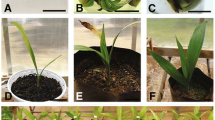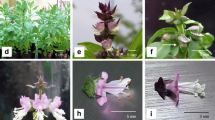Abstract
To date, plantlet culture has not been explored as a means to obtain secondary metabolites in vitro. However, plantlets readily produce desirable secondary metabolites, which may not be produced in cell suspension or callus cultures. To optimize plantlet growth in vitro, the influences of various physical environments on the growth (fresh weight), morphogenesis (leaf, root, and shoot number), and volatile carbon metabolites (i.e. monoterpene, (−)-carvone) of Mentha spicata L. (spearmint) plants were studied. The carvone content in different portions of sterile plantlets was analyzed. Carvone was only produced from the foliar regions of cultured plantlets and was absent in the callus and roots. The influence of physical support (e.g., agar, glass gravel, liquid, platform or sponge), frequency of media replacement, and culture vessel capacity on spearmint plantlets growth and carvone production was tested. A comparative study was conducted testing the growth, morphogenesis, and secondary metabolism occurring with three different spearmint cultivars grown in either culture tubes containing 25 ml agar medium or in an automated plant culture system (APCS; a sterile hydroponics system) employing a 1-l medium reservoir. Increasing the number of media immersions (4, 8, 12 or 16 immersions d−1) of plantlets growing in the APCS increased growth and morphogenesis responses. Generally, higher culture growth rates resulted in lower carvone treatment−1 (mg carvone g-FW−1); however, overall total carvone ((mg carvone g-FW−1) × g culture FW) increased because of the production of greater biomass obtained per vessel.








Similar content being viewed by others
References
Bourgaud, F.; Gravot, A.; Milesi, S.; Gontier, E. Production of plant secondary metabolites: a historical perspective. Plant Sci. 161:839–851; 2001.
Charlwood, B. V.; Charlwood, K. A.; Molina-Torres, J. Accumulation of secondary compounds by organized plant cultures. In: Charlwood, B.V.; Rhodes, M. J. C., eds. Secondary Products from Plant Tissue Culture. Oxford: Clarendon Press; 1990: 167–200.
Curtin, M. E. Harvesting profitable products from plant tissue culture. Biotechnology 1:649–657; 1983.
Giri, A.; Narasu, M. L. Transgenic hairy roots: recent trends and applications. Biotechnol. Adv. 18:1–22; 2000.
Gulmon, S. L.; Mooney, H. A. Costs of defense and their effects on plant productivity. In: Givnish, T. J., ed. On the Economy of Plant Form and Function, Cambridge Univ. Press; 1986: 681–698.
Guern, J.; Renaudin, J. P.; Brown, S. C. The compartmentation of secondary metabolites in plant cell cultures. In: Constabel, F.; Vasil, I. K., eds. Cell Culture and Somatic Cell Genetics of Plants, Vol 4. San Diego–London: Academic Press; 1987: 43–76.
Hallahan, D. L. Monoterpenoid biosynthesis in glandular trichomes of Labiatae plants. Adv. Bot. Res. 31:77–120; 2000.
Haven-Frankel, D.; Dorn, R.; Leustek, T. Plant tissue culture for production of secondary metabolites. Food Technol. 51:56–61; 1997.
Herms, D. A.; Mattson, W. J. The dilemma of plants: to grow or defend. Q. Rev. Biol. 67:283–305; 1992.
Matyssek, R.; Schnyder, H.; Elstner, E.-F.; Munch, J.-C.; Pretzsch, H.; Sandermann, H. Growth and parasite defence in plants: the balance between resource sequestration and retention: in lieu of a guest editorial. Plant Biol. 4:133–136; 2002.
Murashige, T.; Skoog, F. A revised medium for rapid growth and bioassays with tobacco tissue culture. Physiol. Plant. 15:473–497; 1962.
Rao, S. R.; Ravishankar, G. A. Plant cell cultures: chemical factories of secondary metabolites. Biotechnol. Adv. 20:101–153; 2002.
Shanker, S.; Ajayakumar, P. V.; Sangwan, N. S.; Kumar, S.; Sangwan, R. S. Essential oil gland number and ultrastructure during Mentha arvensis leaf ontogeny. Biol. Plant. 42:379–387; 1999.
Tisserat, B. Growth responses and construction costs of various tissue culture systems. HortTechnology 6:62–68; 1996.
Tisserat, B.; Silman, R. Interactions of culture vessels, media volume, culture density, and carbon dioxide levels on lettuce and spearmint shoot growth in vitro. Plant Cell Rep. 19:464–471; 2000.
Tisserat, B.; Vaughn, S. F. Essential oils enhanced by ultra-high carbon dioxide levels from Lamiaceae species grown in vitro and in vivo. Plant Cell Rep. 20:361–368; 2001.
Tisserat, B.; Vaughn, S. F.; Silman, R. Influence of modified oxygen and carbon dioxide atmospheres on mint and thyme plant growth, morphogenesis and secondary metabolism in vitro. Plant Cell Rep. 20:912–916; 2002.
Turner, G. W.; Gershenzon, J.; Croteau, R. B. Distribution of peltate glandular trichomes on developing leaves of peppermint. Plant Physiol. 124:655–664; 2000.
Vanisree, M.; Lee, C.-Y.; Lo, S.-F.; Nalawade, S. M.; Lin, C. Y.; Tsay H.-S. Studies on the production of some important secondary metabolites from medicinal plants by plant tissue cultures. Bot. Bull. Acad. Sin. 45:1–22; 2004.
Verpoorte, R.; Contin, A.; Memelink, J. Biotechnology for the production of plant secondary metabolites. Phytochem. Rev. 1:13–25; 2002.
Verpoorte, R. A.; van der Heijden, R.; Memellink, J. Engineering the plant cell factory for secondary metabolite production. Transgenic Res. 9:323–343; 2000.
Zhong, J.-J.; Pan, Z.-W.; Wang, Z.-Y.; Wu, J.; Chen, F.; Takagi, M.; Yoshida, T. Effect of mixing time on taxoid production using suspension cultures of Taxus chinensis in a centrifugal impeller bioreactor. J. Biosci. Bioeng. 94:244–250; 2002.
Acknowledgments
The authors wish to thank R. K. Holloway and T. Tisserat for the chemical analysis and D. Palmquist for the statistical analyses. Names are necessary to report factually on available data; however, the USDA neither guarantees nor warrants the standard of the product, and the use of the name by USDA implies no approval of the product to the exclusion of others that may also be suitable.
Author information
Authors and Affiliations
Corresponding author
Additional information
Editor: P. Weathers
Rights and permissions
About this article
Cite this article
Tisserat, B., Vaughn, S.F. Growth, morphogenesis, and essential oil production in Mentha spicata L. plantlets in vitro . In Vitro Cell.Dev.Biol.-Plant 44, 40–50 (2008). https://doi.org/10.1007/s11627-007-9077-y
Received:
Accepted:
Published:
Issue Date:
DOI: https://doi.org/10.1007/s11627-007-9077-y




